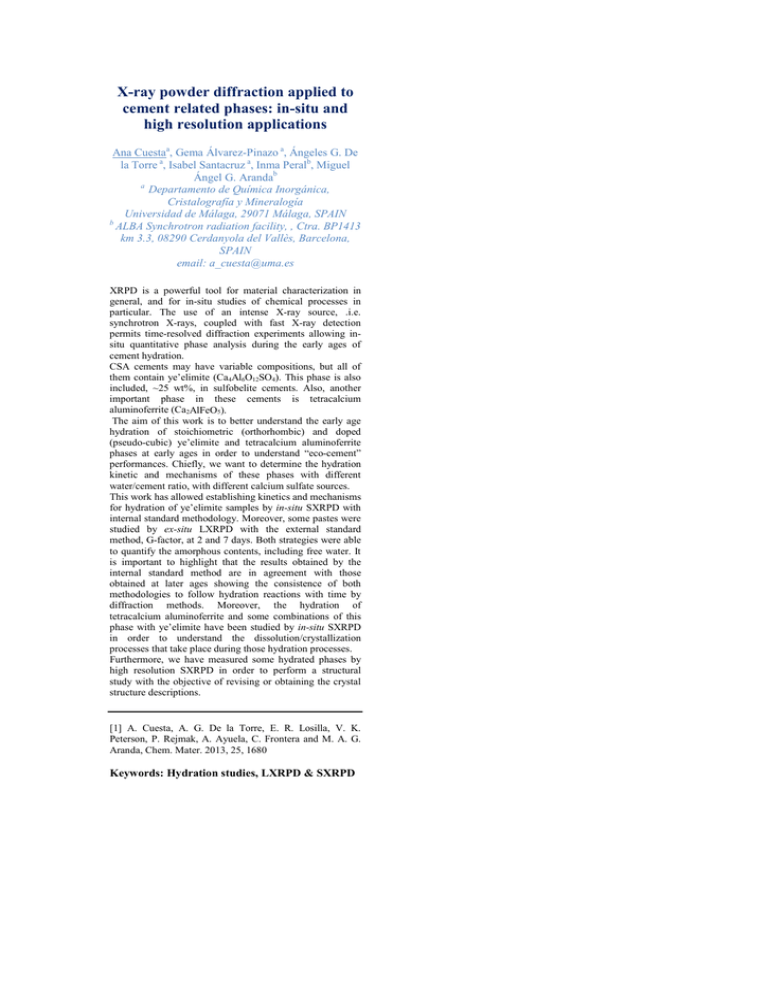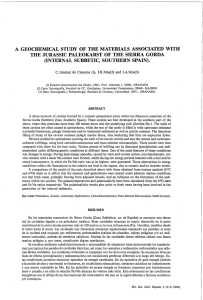X-ray powder diffraction applied to cement related phases: in
Anuncio

X-ray powder diffraction applied to cement related phases: in-situ and high resolution applications Ana Cuestaa, Gema Álvarez-Pinazo a, Ángeles G. De la Torre a, Isabel Santacruz a, Inma Peralb, Miguel Ángel G. Arandab a Departamento de Química Inorgánica, Cristalografía y Mineralogía Universidad de Málaga, 29071 Málaga, SPAIN b ALBA Synchrotron radiation facility, , Ctra. BP1413 km 3.3, 08290 Cerdanyola del Vallès, Barcelona, SPAIN email: [email protected] XRPD is a powerful tool for material characterization in general, and for in-situ studies of chemical processes in particular. The use of an intense X-ray source, .i.e. synchrotron X-rays, coupled with fast X-ray detection permits time-resolved diffraction experiments allowing insitu quantitative phase analysis during the early ages of cement hydration. CSA cements may have variable compositions, but all of them contain ye’elimite (Ca4Al6O12SO4). This phase is also included, ~25 wt%, in sulfobelite cements. Also, another important phase in these cements is tetracalcium aluminoferrite (Ca2AlFeO5). The aim of this work is to better understand the early age hydration of stoichiometric (orthorhombic) and doped (pseudo-cubic) ye’elimite and tetracalcium aluminoferrite phases at early ages in order to understand “eco-cement” performances. Chiefly, we want to determine the hydration kinetic and mechanisms of these phases with different water/cement ratio, with different calcium sulfate sources. This work has allowed establishing kinetics and mechanisms for hydration of ye’elimite samples by in-situ SXRPD with internal standard methodology. Moreover, some pastes were studied by ex-situ LXRPD with the external standard method, G-factor, at 2 and 7 days. Both strategies were able to quantify the amorphous contents, including free water. It is important to highlight that the results obtained by the internal standard method are in agreement with those obtained at later ages showing the consistence of both methodologies to follow hydration reactions with time by diffraction methods. Moreover, the hydration of tetracalcium aluminoferrite and some combinations of this phase with ye’elimite have been studied by in-situ SXRPD in order to understand the dissolution/crystallization processes that take place during those hydration processes. Furthermore, we have measured some hydrated phases by high resolution SXRPD in order to perform a structural study with the objective of revising or obtaining the crystal structure descriptions. [1] A. Cuesta, A. G. De la Torre, E. R. Losilla, V. K. Peterson, P. Rejmak, A. Ayuela, C. Frontera and M. A. G. Aranda, Chem. Mater. 2013, 25, 1680 Keywords: Hydration studies, LXRPD & SXRPD








